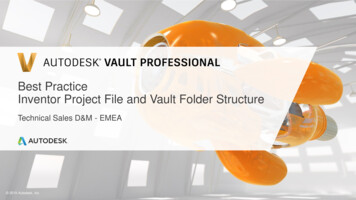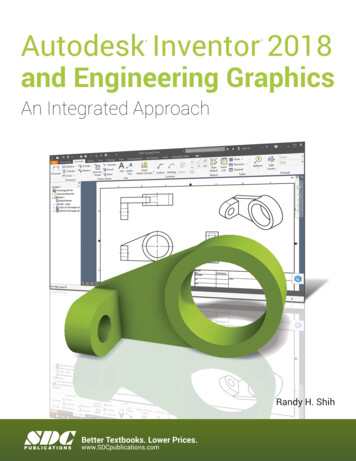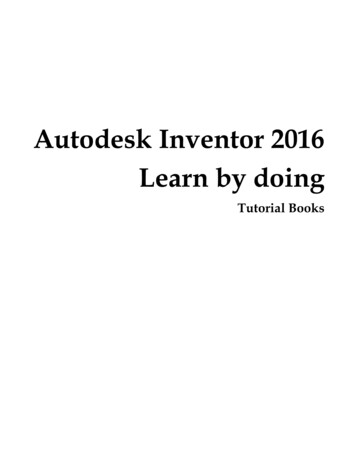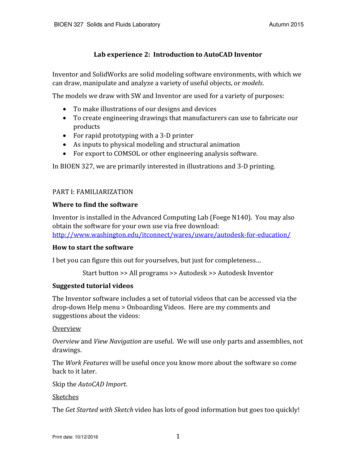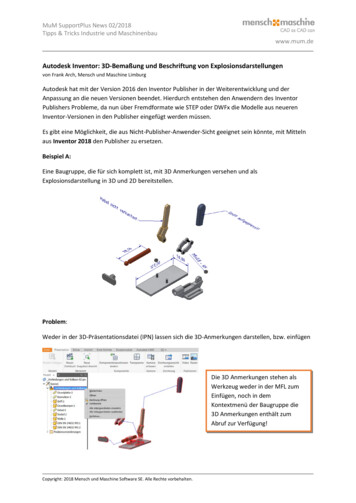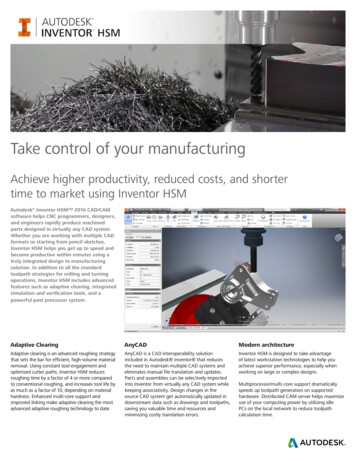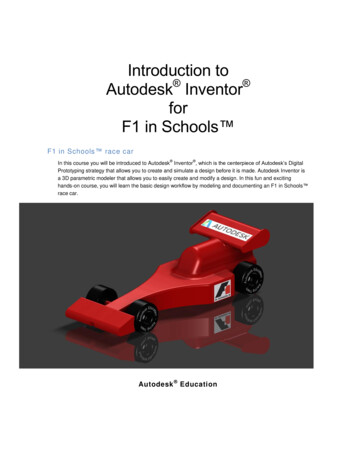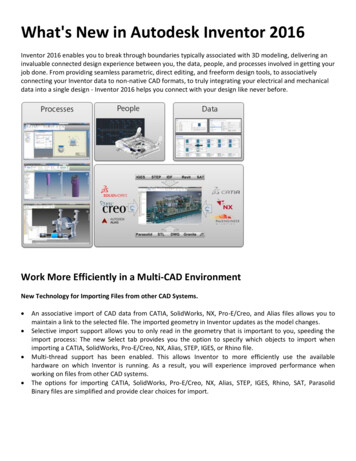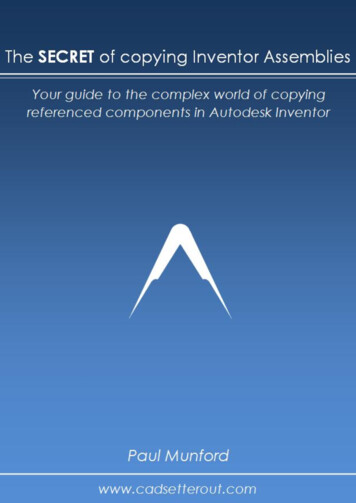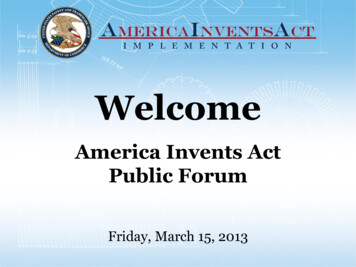
Transcription
WelcomeAmerica Invents ActPublic ForumFriday, March 15, 2013
Public Forum AgendaTimeTopic1:00 PM to 1:15 PMOpening RemarksActing Under Secretary of Commerce for Intellectual Property andActing Director of the USPTO Teresa Stanek Rea1:15 PM to 2:30 PMFirst Inventor to File Final Rules and GuidanceMary Till, Senior Legal AdvisorKathleen Fonda, Senior Legal AdvisorOffice of Patent Legal Administration2:30 AM to 2:45 AMBREAK2:45 PM to 3:55 PMMicro Entity and Patent Fees: Final RulesJames Engel, Senior Legal AdvisorOffice of Patent Legal AdministrationMichelle Picard, Senior Advisor for Financial ManagementOffice of the Chief Financial Officer3:55 PM to 4:00 PMClosing Remarks2
Introductory RemarksActing Under Secretary of Commerce for IntellectualProperty and Acting Director of the USPTOTeresa Stanek Rea
Status ReportJanet GongolaPatent Reform Coordinator4
AIA Enactment TimelineDay of EnactmentSept 16, 201110 DaysSept 26, 2011Reexamination transition forthresholdPrioritizedExaminationTax strategies are deemedwithin prior art15% transitionSurchargeOct 1, 2011ReserveFund60 DaysNov 15, 2011ElectronicfilingincentiveBest modeHuman organismprohibitionOED statute of limitations12 MonthsSept 16, ion18 MonthsMar 2013First inventor to peal of statutoryinventionregistrationCitation of prior art in apatent fileNew patent feesInter partes reviewMicro entitydiscountPost-grant reviewTransitionalpost-grant reviewprogram for coveredbusiness methodpatentsProvisions are enacted5
Prioritized Exam Statistics(Data from Sept 26, 2011 to Feb19, 2013)Petitions Filed8,554First Actionon MeritsMailed5,503% of DecidedPetitionsGrantedDays fromAverage DaysPetitionto FinalGrant to FirstDispositionOffice 3,6671,828168Percent ofPetitionsFromSmallEntities43%6
Preissuance Submissions(Data from Sept 16, 2012 to Feb 28, 2013)http://www.uspto.gov/aia implementation/statistics.jsp7
Supplemental Examination(Data from Sept 16, 2012 to Feb 28, 2013)http://www.uspto.gov/aia implementation/statistics.jsp8
Inter Partes Review(Data from Sept 16, 2012 to Feb 28, 2013)http://www.uspto.gov/aia implementation/statistics.jsp9
Covered Business Method Review(Data from Sept 16, 2012 to Feb 28, 2103)http://www.uspto.gov/aia implementation/statistics.jsp10
AIA Micro-site: New Featureswww.uspto.gov/AmericaInventsAct Statistics showing number of filing for new AIAproceedings Landing page blogs to share information aboutstrengths and points for improvement for newAIA proceedings Frequently Asked Questions for FITF, microentity, and new patent fees11
First Inventor to FileFinal Rules and Guidelines
OverviewPart 1: Examiner Training and AIA IndicatorsPart 2: Guidelines Statutory framework and comparison 35 U.S.C. 102(a)(1) prior art and 102(b)(1) exceptions 35 U.S.C. 102(a)(2) prior art and 102(b)(2) exceptionsPart 3: Rules 37 C.F.R. 1.55 and 1.78– filing certified copy of foreign priority document– statements in transitional applications 37 C.F.R. 1.130– attribution exception– prior public disclosure exception13
Summary of Examiner Training Three-part overview training (March-April 2013)– Introductory Video: background for overview training– Live Training: 20 training sessions– Follow-up Video: statutory review and illustrations Comprehensive training (June-July 2013) Just-in-time training as needed (March-July 2013)14
AIA Indicators Applicants can view PAIR to find out whether anapplication is being examined under the AIA or underpre-AIA law Certain USPTO forms received with Office actions alsowill include an AIA indictor Examiners will have indicators in our internal ITsystems (i.e., eDAN and PALM) to show whether anapplication has been identified as subject to the AIA orto pre-AIA law15
AIA Indicator in PAIR16
AIA Indicator 0n Office Action Summary17
AIA Indicator on Notice of Allowability18
GuidelinesExamination Guidelines for Implementing theFirst Inventor to File Provisions of the Leahy-Smith AmericaInvents Act , 78 Fed. Reg. 11059(February 14, 2013)Effective Date: March 16, 201319
Critical Date for Claimed Invention Pre-AIA: date of invention AIA: effective filing date20
35 U.S.C. 100(i)(1):New Definition for Effective Filing DateEffective filing date of a claimed invention under examinationis the earlier of:– the actual filing date of the patent or application containinga claim to the invention;or– the filing date of the earliest application for which thepatent or application is entitled to a right of foreignpriority or domestic benefit as to such claimedinvention21
AIA Impact on pre-AIA 35 U.S.C. 102Pre-AIA 35 U.S.C. 102A person shall be entitled to a patent unless—(a) the invention was known or used by others in this country, or patented or described in a printed publication in this or aforeign country, before the invention thereof by the applicant for patent, orAIA 35 U.S.C. 102Concordance102(a)(1)(b) The invention was patented or described in a printed publication in this or a foreign country or in public use or on salein this country, more than one year prior to the date of the application for patent in the United States, or(c) He has abandoned the invention, orAbandonment of invention(d) The invention was first patented or caused to be patented, or was the subject of an inventor’s certificate, by theapplicant or his legal representatives or assigns in a foreign country prior to the date of the application for patent in thiscountry on an application for patent or inventor’s certificate filed more than twelve months before the filing date of theapplication in the United States, orPremature foreign patenting102(a)(2)(e) The invention was described in(1)(2)No correspondingprovisionAn application for patent, published under section 122(b), by another filed in the United States before the inventionby the applicant for patent orA patent granted on an application for patent by another filed in the United States before the invention by theapplicant for patent, except than an international application filed under the treaty defined in section 351(a) shallhave the effects for the purposes of this subsection of an application filed in the United States only if the internationalapplication designated the United States and was published under Article 21(2) of such treaty in the Englishlanguage, or(f) He did not himself invent the subject matter soughtto be patented, orDerivation101 and 115(g)(1) during the course of an interference conduced under section 135 or section 291, another inventor involved thereinestablishes, to the extent permitted in section 104, that before such person’s invention thereof the invention was madeby such other inventor and not abandoned, suppressed, or concealed, or(2) Before such person’s invention thereof, the invention was made in this country by another inventor who had notabandoned, suppressed, or concealed it.Prior invention by anotherNo correspondingprovision22
AIA Statutory FrameworkPrior Art35 U.S.C. 102(a)(Basis for Rejection)102(a)(1)Disclosure with PriorPublic Availability Date102(a)(2)U.S. Patent,U.S. Patent Application,and PCT Applicationwith Prior Filing DateExceptions35 U.S.C. 102(b)(Not Basis for Rejection)102(b)(1)(A)Grace Period Disclosure by Inventor orObtained from Inventor(B)Grace Period Intervening Disclosure byThird Party(A)Disclosure Obtained from Inventor102(b)(2)(B)Intervening Disclosure by Third Party(C)Commonly Owned Disclosure23
35 U.S.C. 102(a)(1):Prior Public Disclosures as Prior Art 35 U.S.C. 102(a)(1) precludes a patent if a claimedinvention was, before the effective filing date of theclaimed invention:o patented;o described in a printed publication;o in public use;o on sale; oro otherwise available to the public24
In Public Use or On Sale Does not include pre-AIA geographic limitation– Use or sale may occur anywhere in the world Does not include pre-AIA treatment of secretsale as prior art– Sale activity must have been available to the public25
“Otherwise Available to the Public” Introduced by the AIA; no correspondinglanguage in pre-AIA 35 U.S.C. 102 Catch-all to account for other means of makingan invention publicly available26
Two Exceptions to35 U.S.C. 102(a)(1)Prior ArtIn brief– 102(b)(1)(A): A grace period disclosure of the inventor’swork is not prior art to the inventor 102(b)(1)(B): A disclosure of the inventor’s work shieldsthe inventor from the prior art effect of a third party’ssubsequent grace period disclosureNote that the 102(b)(1) exceptions pertain to the 102(a)(1)disclosures, which may be prior art as of the date they arepublicly available27
35 U.S.C. 102(b)(1)(A) Exception:Grace Period Disclosure of Inventor’s WorkFirst exception: A disclosure made one year orless before the effective filing date of the claimedinvention shall not be prior art under 35 U.S.C.102(a)(1) if:the disclosure was made by:–the inventor or joint inventor; or–another who obtained the subject matterdirectly or indirectly from the inventor orjoint inventor28
Example 1: Exception in 102(b)(1)(A)July 1, 2013July 1, 2014Taylor publishes XTaylor filespatentapplicationclaiming XInventor Taylor’s Grace Period Taylor’s publication is not available as prior art against Taylor’sapplication because of the exception under 102(b)(1)(A) for a grace perioddisclosure by an inventor.29
Example 2: Exception in 102(b)(1)(A)Smith publishes XJuly 1, 2013July 1, 2014Taylor files patentapplicationclaiming XInventor Taylor’s Grace Period Smith’s publication would be prior art to Taylor under 102(a)(1) if it doesnot fall within any exception in 102(b)(1). However, if Smith obtained subject matter X from Taylor, then it fallsinto the 102(b)(1)(A) exception as a grace period disclosure obtainedfrom the inventor, and is not prior art to Taylor.30
35 U.S.C. 102(b)(1)(B) Exception:Grace Period Intervening Disclosure by Third PartySecond exception: A disclosure made one year or lessbefore the effective filing date of the claimedinvention shall not be prior art under35 U.S.C. 102(a)(1) if:the subject matter disclosed was, before suchdisclosure, publicly disclosed by:– the inventor or joint inventor; or– another who obtained the subject matter directlyor indirectly from the inventor or joint inventor31
“The Subject Matter” For the 35 U.S.C. 102(b)(1)(B) exception to apply:– the subject matter in the prior disclosure must be thesame as that which is later publicly disclosed– the mode of prior disclosure by the inventor need notbe the same as the mode of later disclosure by another– verbatim disclosures are not required32
Example 3: Exception in 102(b)(1)(B)Smith publishes XJuly 1, 2013Taylorpublishes XJuly 1, 2014Taylor files patentapplicationclaiming XInventor Taylor’s Grace Period Smith’s publication is not prior art because of the exception under 102(b)(1)(B) fora grace period intervening disclosure by a third party.Taylor’s publication is not prior art because of the exception under 102(b)(1)(A) fora grace period disclosure by the inventor.If Taylor’s disclosure had been before the grace period, it would be prior artagainst his own application. However, it would still render Smith inapplicable asprior art.33
AIA Statutory FrameworkPrior Art35 U.S.C. 102(a)(Basis for Rejection)102(a)(1)Disclosure with PriorPublic Availability Date102(a)(2)U.S. Patent,U.S. Patent Application,and PCT Applicationwith Prior Filing DateExceptions35 U.S.C. 102(b)(Not Basis for Rejection)102(b)(1)(A)Grace Period Disclosure by Inventor orObtained from Inventor(B)Grace Period Intervening Disclosure byThird Party(A)Disclosure Obtained from Inventor102(b)(2)(B)Intervening Disclosure by Third Party(C)Commonly Owned Disclosure34
35 U.S.C. 102(a)(2): U.S. and PCT Patent Documents ArePrior Art as of the Date They Are “Effectively Filed”35 U.S.C. 102(a)(2) precludes a patent if a claimedinvention was described in a:o U.S. Patent;o U.S. Patent Application Publication; oro PCT Application Publication designating the U.S.that names another inventor and was effectively filedbefore the effective filing date of the claimed invention35
35 U.S.C. 102(d): Determining the Date that a U.S. orPCT Patent Document Is “Effectively Filed” Date that a U.S. or PCT patent document being applied as a referenceis effectively filed is the earlier of:– the actual filing date of the U.S. patent or published application;or– the filing date of the earliest application to which the U.S. patent orpublished application is entitled to claim a right of foreign priorityor domestic benefit which describes the subject matter Date that a patent document used as a reference is effectively filedmay be different depending on whether the application underexamination is subject to AIA or pre-AIA law36
Three Exceptions to35 U.S.C. 102(a)(2)Prior ArtIn brief– 102(b)(2)(A): A disclosure of the inventor’s work in a U.S. patentdocument or PCT publication by another is not prior art to the inventor 102(b)(2)(B): A disclosure of the inventor’s work shields the inventorfrom the prior art effect of a subsequent disclosure in a U.S. patentdocument or PCT publication 102(b)(2)(C): A disclosure is not prior art to the inventor if it wascommonly owned with the claimed invention not later than the inventor’seffective filing dateNote that the 102(b)(2) exceptions pertain to the 102(a)(2) patentdocuments, which may be prior art as of the date that they are effectivelyfiled. Grace period is not relevant.37
35 U.S.C. 102(b)(2)(A) Exception:Disclosure Obtained from InventorFirst exception: A disclosure in an application orpatent shall not be prior art under 35 U.S.C.102(a)(2) if:the disclosure was made by another whoobtained the subject matter directly orindirectly from the inventor or joint inventor38
Example 4: Exception in 102(b)(2)(A)Smith’sapplicationpublishesSmith filespatent applicationdisclosing XOctober 1, 2015April 1, 2014July 1, 2014Taylor filespatent applicationclaiming X Smith’s patent application publication is not prior art if Smithobtained X from Inventor Taylor because of the exception under102(b)(2)(A) for a disclosure obtained from the inventor39
35 U.S.C. 102(b)(2)(B) Exception:Intervening Disclosure by Third PartySecond exception: A disclosure in an application orpatent shall not be prior art under 35 U.S.C. 102(a)(2)if:the subject matter disclosed was, before suchsubject matter was effectively filed, publiclydisclosed by:–the inventor or joint inventor; or–another who obtained the subject matterdirectly or indirectly from the inventor orjoint inventor40
Example 5: Exception in 102(b)(2)(B)Smith filespatent applicationdisclosing XSmith’sapplicationpublishesApril 1, 2014March 1, 2014Taylorpublishessubject matter X October 1, 2015July 1, 2014Taylor filespatent applicationclaiming XSmith’s patent application publication is not prior art against Taylor’sapplication because of the exception under 102(b)(2)(B) for an interveningdisclosure by a third party.41
35 U.S.C. 102(b)(2)(C) Exception:Commonly Owned DisclosureThird exception: A disclosure made in an application orpatent shall not be prior art under 35 U.S.C. 102(a)(2) if:the subject matter and the claimed invention werecommonly owned or subject to an obligation ofassignment to the same person not later than theeffective filing date of the claimed inventionResembles pre-AIA 35 U.S.C. 103(c), but applies to bothnovelty and obviousness, whereas pre-AIA disqualified artonly for obviousness42
Commonly Owned orSubject to Obligation of Assignment Applicant can establish common ownership orobligation of assignment by making a clear andconspicuous statement Corroborating evidence is not required43
Example 6: Exception in 102(b)(2)(C)Smith inventsX and assignsto Company ZSmith filespatentapplicationdisclosing XMarch 1, 2014April 1, 2014February 1, 2014Taylor invents X andassigns to Company ZJuly 1, 2014Taylor files patentapplication claiming X Smith’s patent application publication is not prior art because of theexception under 102(b)(2)(C) for a commonly owned disclosure. There is no requirement that Smith’s and Taylor’s subject matter bethe same in order for the common ownership exception to apply.44
RulesChanges to Implement the First Inventor to FileProvisions of the Leahy-Smith America Invents Act,78 Fed. Reg. 11024 (February 14, 2013)Effective Date: March 16, 201345
Important Rules for AIA Applications 37 C.F.R. 1.55 and 1.78–filing certified copy of foreign priority document–statements in transitional applications 37 C.F.R. 1.130–attribution exception–prior public disclosure exception46
Rule 1.55(a), (b), (d), and (e):Foreign Priority in a 35 U.S.C. 111(a) Application To take advantage of the new definition of “effective filing date”which includes a foreign filing date, applicant must:– claim foreign priority within the later of: 4 months from the actual filing date of the application; or 16 months from the filing date of the foreign priorityapplicationand– include the foreign priority in an application data sheet (ADS) Foreign priority claimed is waived if omitted from the ADS Unintentionally delayed claim may be accepted by petition47
Rule 1.55(f):Certified Copy of Foreign Priority Document Certified copy of any foreign priority application must be filedwithin the later of:– 4 months from the actual filing date; or– 16 months from the filing date of the prior foreign applicationunless an exception applies Certified copy is needed since U.S. patents and U.S. patent applicationpublications have prior art effect as of the date that they are effectivelyfiled, which might be the foreign priority date48
Rule 1.55(f)-(i): Three Ways to Satisfy theTime Limit Requirement to File theCertified Copy Applicant files a certified copy of the foreign priority document withthe Office within the 4/16 time period Applicant authorizes Office to retrieve a copy of the foreign priorityapplication through the Office’s Priority Document ExchangeProgram (PDX) Applicant files interim copy of the foreign priority within the 4/16time period In order to perfect foreign priority, the certified copy of the foreignpriority document or a copy retrieved via PDX, must be received bythe Office no later than patent grant49
Rule 1.55(j), 1.78(a)(6), or 1.78(c)(6):Statements in Transitional Applications Nonprovisional applications that are:– filed on or after March 16, 2013;and– claim foreign priority or domestic benefit of anapplication filed before March 16, 2013,are called transitional applications If a transitional application has ever included a claim to aninvention having an effective filing date on or after March 16,2013, applicant must provide a statement to that effect50
Rule 1.55(j), 1.78(a)(6), or 1.78(c)(6):Statements in Transitional ApplicationsFiled beforeMarch 16, 2013;Priority/Benefitclaim beforeMarch 16, 2013No statement required;pre-AIA applicationFiled on or afterMarch 16, 2013;Priority/Benefitclaim beforeMarch 16, 2013Statement required if theapplication ever included aclaim to an invention havingan effective filing date on orafter March 16, 2013;transitional applicationFiled afterMarch 16, 2013;Priority/Benefitclaim afterMarch 16, 2013NO statement required;AIA application51
Rule 1.55(j), 1.78(a)(6), or 1.78(c)(6):Statements in Transitional Applications Applicant is not required to identify how many or which claimshave an effective filing date on or after March 16, 2013 A statement is not required if applicant reasonably believes thatthe application does not, and did not at any time, contain a claimthat has an effective filing date on or after March 16, 2013 A statement is not required for transitional applications that addunclaimed subject matter, which if claimed would have aneffective filing date on or after March 16, 201352
Rule 1.55(j), 1.78(a)(6), or 1.78(c)(6):Timing of Statements for TransitionalApplicationsStatements must be filed within the later of:– 4 months from the actual filing date of the later-filedapplication;– 4 months from the date of entry into the national stage;– 16 months from the filing date of the prior-filed applicationfrom which benefit or priority is sought;or– the date that a first claim having an effective filing date on orafter March 16, 2013, is presented in the later-filed application.53
Rule 1.130 Affidavits or Declarations Revised rule 1.130 provides a mechanism for anapplicant or patent owner to provide informationrelevant to certain prior art exceptions:– affidavit or declaration of attribution under1.130(a), to invoke the 102(b)(1)(A) or 102(b)(2)(A)exception– affidavit or declaration of prior public disclosureunder 1.130(b), to invoke the 102(b)(1)(B) or102(b)(2)(B) exception54
Rule 1.130(a):Affidavit or Declaration of Attribution In response to a rejection based on a disclosure, applicant orpatent owner may submit an affidavit or declaration ofattribution attesting that the disclosure was made– by the inventor or joint inventor;or– by another who obtained the subject matter discloseddirectly or indirectly from the inventor or joint inventor Declaration or affidavit may be used to overcome a rejectionbased on 102(a)(1) or 102(a)(2) prior art by invoking the102(b)(1)(A) or 102(b)(2)(A) exception, respectively55
Rule 1.130(b):Affidavit or Declaration of Prior Public Disclosure In response to a rejection based on a disclosure, applicant orpatent owner may submit an affidavit or declaration of priorpublic disclosure attesting that a prior public disclosureof the subject matter was made– by the inventor or joint inventoror– by another who obtained the subject matter discloseddirectly or indirectly from the inventor or joint inventor Declaration or affidavit may be used to overcome a rejectionbased on 102(a)(1) or 102(a)(2) prior art by invoking the102(b)(1)(B) or 102(b)(2)(B) exception, respectively56
Rule 1.130(c):Affidavit or Declaration Not Available An affidavit or declaration is not available to overcome arejection if:– the rejection is based on a disclosure made more thanone year before effective filing date of claimed invention An affidavit or declaration under rule 1.130 may notavailable to overcome a rejection if:– the affidavit or declaration contends that the inventornamed in prior art U.S. patent or U.S. patent applicationpublication derived the claimed invention57
Resources Statutory Framework Chart:http://www.uspto.gov/aia implementation/FITF card.pdf FAQs:http://www.uspto.gov/aia implementation/faqs first inventor.jsp Examiner Introductory Video: http://helix-1.uspto.gov/asxgen/AIAClose Cpt.wmv Examiner Overview Training Slides: (available on AIA micro-site soon) Examiner Follow-up Video: (available on AIA micro-site soon)58
Questions?59
Micro EntityChanges to Implement Micro Entity Status for PayingPatent Fees, 77 Fed. Reg. 75019 (December 19, 2012)Effective March 19, 201360
Benefits 75% discount on fees for “filing, searching,examining, issuing, appealing, andmaintaining” patent applications/patents Discount does not apply to fees paid by athird party (e.g., administrative trials)61
Establishing Micro entity Status:Option 1 Applicant must certify that the applicant:– Qualifies as a small entity;– Has not been named as an inventor on more than 4 previouspatent applications;– Did not have a gross income exceeding 3 times the medianhousehold income in the preceding calendar year;and– Did not convey a license or other ownership interest in theapplication to an entity that had a gross income exceeding 3times the median household income in the preceding calendaryear (and not obligated to do so)62
Option 1:Application Filing Limit Each inventor and each applicant is limited to “four previously filedpatent applications” in which he or she was “named as the inventoror a joint inventor”Applications IncludedCount all Pending, Patented,and Abandoned:U.S. NonprovisionalApplications ExcludedForeign(New, Continuing, and Divisional)Utility and DesignProvisionalNational Stage (PCT)PCT International Stage if U.S. national stage filing fee not paidReissueSection 1.29(b) exclusion:Application in which “all ownership rights” wereassigned or are obligated to be assigned by theinventor or non-inventor applicant “as the result of”the inventor’s or applicant’s “previous employment”63
Option 1:Gross Income Limit If the application names joint inventors:– Income requirement applies to each applicant’s andeach inventor’s income separately Any licensee or assignee must also meet the incomerequirement64
Example 1: Disqualification UnderOption 1 Joint inventor in a pending patent application was namedas an inventor in:– 3 abandoned U.S. nonprovisional patent applications;– 1 U.S. patent; and– 1 U.S. reissue application Result Applicant does not qualify for micro entity statusbecause joint inventor was named as an inventor on morethan “four previously filed patent applications”65
Example 2: Disqualification underOption 1 Joint inventor assigned rights in the invention to acorporation with revenue exceeding 2 billion per year Result applicant does not qualify for micro entity statusunder Option #1 because joint inventor assigned rights inthe invention to an entity that exceeds the gross incomelimit If assignee corporation has under 500 employees,applicant might be entitled to small entity status66
Establishing Micro entity Status:Option 2Applicant must certify that: Applicant qualifies as a small entity;AND Applicant’s employer, from which he/she obtains themajority of his/her income, is an institution of highereducation; OR Applicant has conveyed a license or other ownershipinterest in the application to such an institution of highereducation (or is obligated to do so)67
Option 2: Institution of HigherEducation Defined in section 101(a) of the Higher Education Act of 1965 “Institution of higher education” must, among other requirements:– be located in a “State;”– be a public or other nonprofit institution legally authorized withinsuch “State;”and– provide a post-secondary educational program that: Awards a bachelor’s degree or provides not less than a 2 yearprogram acceptable for full credit toward such a degree, or Awards a degree that is acceptable for admission to a graduateor professional degree program68
Example 3: Qualification underOption 2 University meeting “institution of higher education” criteria uses aseparate research foundation for technology transfer 2 of the 3 inventors obtain the majority of their income asemployees of the university Third inventor is an uncompensated undergraduate student 3 inventors are identified as the applicant Each inventor assigned their rights in the application to theresearch foundation Result Applicant would qualify for micro entity status if:(1) the undergraduate student can qualify under option #1, and(2) the research foundation is a small entity and meets the grossincome limit of option #169
Example 4: Disqualification underOption 2 Same as Example #3, except that one of the inventorsleaves the university and refuses to cooperate with theresearch foundation Research foundation files the application as the applicant Result Unless the research foundation can qualifyunder Option #1, micro entity status is not available,because the research foundation is not an employee of theuniversity and has not conveyed to the university70
Example 5: Option 2 Qualification All inventors conveyed their rights in the subject application toa university meeting the “institution of higher education”criteria Inventors are named as the applicant No party that does not qualify as a small entity has rights in theapplication One inventor’s gross income for the calendar year precedingpayment of the filing fee is 10 times the median householdincome Result Applicant qualifies for micro entity status becausegross income is not relevant to Option #271
Micro Entity Certification Micro entity certification must be filed in anapplication with or before fees may be paid inthe micro entity amount Separate micro entity certification is required foreach application72
Who can sign the certification? A micro entity certification must be signed by:– registered patent practitioner;– inventor named as the sole inventor and identified asthe applicant;or– all inventors named as the joint inventors andidentified as the applicant Micro entity certification for a juristic applicant(assignee-applicant) must be signed by a registeredpatent practitioner73
Micro Entity CertificationForms: Option 174
Micro Entity Certification Form:Option 275
Micro Entity Certification Separate micro entity certification is notrequired for each fee payment– But applicant must be entitled to micro entitystatus whenever a fee is paid in the microentity amount Applicant should evaluate entitlement to microentity status each time a fee payment is made76
Loss of Entitlement Notice of loss of micro entity status must bemade in writing– Payment of a small or large entity fee is notsufficient notification– Notification of loss of micro entity status isnot treated as notice of loss of small entitystatus77
Example 6: Loss of Entitlementunder Option 1 Sole inventor applicant filed a patent application in 2013 accompaniedby a certification of micro entity status Applicant had gross income in 2012 below the “Maximum QualifyingGross Income” reported on the USPTO website when filing, search, andexamination fees were paid in the micro entity amounts Applicant filed a petition for extension of time in 2014 and wasrequired to pay an extension of time fee Applicant’s gross incom
35 U.S.C. 102(a)(1)Prior Art In brief- 102(b)(1)(A): A grace period disclosure of the inventor's work is not prior art to the inventor 102(b)(1)(B): A disclosure of the inventor's work shields the inventor from the prior art effect of a third party's subsequent grace period disclosure


